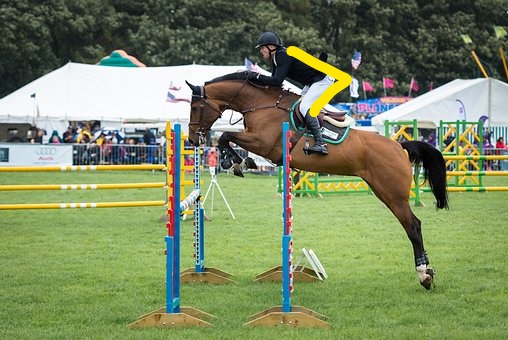 Jumping is one of the most fun things you can do on horseback. Many riders jump for fun but you can also compete in jumping events too. Many hunter/jumpers are incredible to watch, especially at shows and in the Olympics!
Jumping is one of the most fun things you can do on horseback. Many riders jump for fun but you can also compete in jumping events too. Many hunter/jumpers are incredible to watch, especially at shows and in the Olympics!
Jumping can take some practice and both you and your horse need to build up muscle and stamina. Here are a few things you can do whether you are a pro-jumper or beginner to help you and your horse clear those obstacles.
Ride Two-Point with Every Gait
Two-point position will help build muscle. At first, it may seem difficult because your body is not used to it. Try one lap of two-point at a walk, two laps of holding the two-point at a trot, and two to three laps of holding the two-point position at a canter. This is an excellent warm-up for both you and your horse. If you do this every ride, you will notice it will become easier as your muscle builds.
Ground Poles Before Jumps
Lying poles flat on the ground is the first step when preparing for jumping your horse. Walk, trot, and canter over the poles as warm-up. This helps you and your horse figure out speed and distancing with poles before you transform them into jumps. As you progress, you can raise the poles into cavalleti to increase the height and difficulty.
Get Your Gait BEFORE You Jump
Warming up you and your horse is CRUCIAL before jumping. A good warm-up helps prevent injury which is very important. Jumping causes excess strain on joints and tendons as the horse uses its haunches to propel and its front half to absorb the landing. It is important to walk, trot, and canter for at least 15 minutes. This also helps build muscle and stamina for both of you – don’t forget to practice your two-point while warming up too!
Find a good, steady pace at both the trot and canter and keep the tempo. Try not to go too fast or too slow – a good cadence and rhythm that helps move your horse forward without breaking stride or galloping off.
Count Out Loud
When working with poles and cavaletti, count out loud. This helps you learn and count the number of strides in between each pole/cavaletti. If you want to show in jumping classes, this is VERY useful as you will have to memorize a course and knowing the number of strides in between and how to count them on your horse can help with a smooth, effortless looking class.
Watch Your Reins
Many riders (and horses!) get excited about jumping. This can lead to a rider gripping the reins much too tightly or having reins that are too short. If your horse rushes, practice transitions and try some poles and circle work. Having too tight of reins does not allow the to move forward. This can cause the horse to “duck out” or refuse jump. Better yet, knot your reins and practice jumping without them. Hold your hands off the the side like an airplane during pole work or smaller jumps (only with a well-trained horse).
Don’t Stare at the ground
When jumping or doing pole work, it’s very tempting to look at the jumps or poles. Do not look at he ground! Look up and between your horses ears and then at the next jump in line. Your body follows your line of sight and the horse will feel that there is another jump coming or that you are turning. Looking down forces your center of gravity down and forward which can lead to a fall or throw both of you off balance.
You’re Not a Bird
You may feel like a bird soaring through the air on your horse but you’re not a bird! Don’t “perch” on top of your saddle. Be part of your horse as you jump – you guys are a team! Sink your heels down and keep your head up and work on closing the hip angle (pic below).

Keep It Simple
Start by keeping the jumps low and easy at first to build strength and confidence. Starting with large jumps or a full-on course can make your horse lose its confidence and become stressed. If your horse keeps refusing, go back to lower jumps or ground poles and keep it nice and easy. Sometimes it is a good mental and physical break to return to the basics.
Work In a Grid
Working in a grid is an EXCELLENT training method for jumping. It helps you and your horse learn distance and speed while practicing and preparing for larger jumps. A grid is a line of poles or jumps in succession. This is also a great confidence builder because horses are less likely to refuse or run out of the grid. They want to reach the next obstacle in the line rather than run out. Here is a video on how to ride a grid: